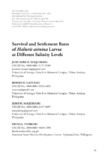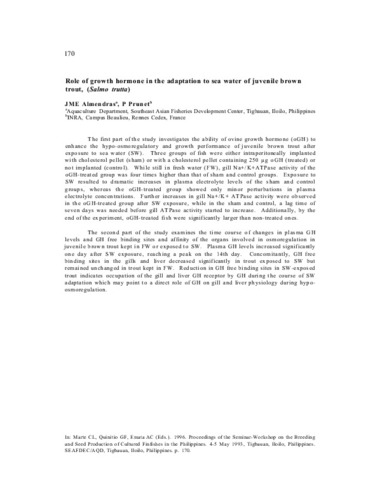| dc.contributor.author | Caberoy, N. B. | |
| dc.contributor.author | Quinitio, G. F. | |
| dc.date.accessioned | 2013-12-19T06:37:49Z | |
| dc.date.available | 2013-12-19T06:37:49Z | |
| dc.date.issued | 2000 | |
| dc.identifier.citation | Caberoy, N. B., & Quinitio, G. F. (2000). Changes in Na+, K+-ATPase activity and gill chloride cell morphology in the grouper Epinephelus coioides larvae and juveniles in response to salinity and temperature. Fish Physiology and Biochemistry, 23(1), 83-94. | en |
| dc.identifier.issn | 0920-1742 | |
| dc.identifier.uri | http://hdl.handle.net/10862/1862 | |
| dc.description.abstract | The activity of the enzyme Na+, K+-ATPase and morphological changes of gill chloride cells in grouper, Epinephelus coioides larvae and juveniles were determined 6–48 h after abrupt transfer from ambient rearing conditions (30–32 ppt, 26.5–30°C) to different salinity (8, 18, 32, 40 ppt) and temperature (25, 30°C) combinations. Na+, K+-ATPase activity in day 20 larvae did not change at salinities 8–32 ppt. Activity decreased significantly (P <0.01) after exposure to 40 ppt at 25–30°C, which was accompanied by an increase (P < 0.05) in density and fractional area of chloride cells. Enzyme activity in 40 ppt did not reach a stable level and larvae failed to recover from an osmotic imbalance that produced a low survival at 25°C and death of all larvae at 30°C. Enzyme activity and chloride cell morphology in day 40 groupers did not change in 8–40 ppt at 25°C and 8–32 ppt at 30°C. A significant decrease and a subsequent increase in Na+, K+-ATPase activity in 40 ppt at 30°C was associated with the increase in chloride cell density resulting in an increased fractional area but a decreased cell size. Enzyme activity and chloride cells of day 60 grouper were unaffected by abrupt transfer to test salinities and temperatures. These results demonstrate that grouper larvae and juveniles are efficient osmoregulators over a wide range of salinities. Salinity adaptation showed an ontogenetic shift as the larvae grew and reached the juvenile stage. This development of tolerance limits may reflect their response to actual conditions existing in the natural environment. | en |
| dc.language.iso | en | en |
| dc.publisher | Springer Verlag | en |
| dc.subject | groupers | en |
| dc.subject | Epinephelus coioides | en |
| dc.subject | Chloride cells | en |
| dc.title | Changes in Na+, K+-ATPase activity and gill chloride cell morphology in the grouper Epinephelus coioides larvae and juveniles in response to salinity and temperature | en |
| dc.type | Article | en |
| dc.citation.volume | 23 | |
| dc.citation.issue | 1 | |
| dc.citation.spage | 83 | |
| dc.citation.epage | 94 | |
| dc.citation.journalTitle | Fish Physiology and Biochemistry | en |
| dc.subject.asfa | cell morphology | en |
| dc.subject.asfa | enzymatic activity | en |
| dc.subject.asfa | gills | en |
| dc.subject.asfa | salinity effects | en |
| dc.subject.asfa | temperature effects | en |
| dc.subject.asfa | salinity | en |
| dc.subject.asfa | temperature | en |
| dc.identifier.doi | 10.1023/A:1007827331137 | |



